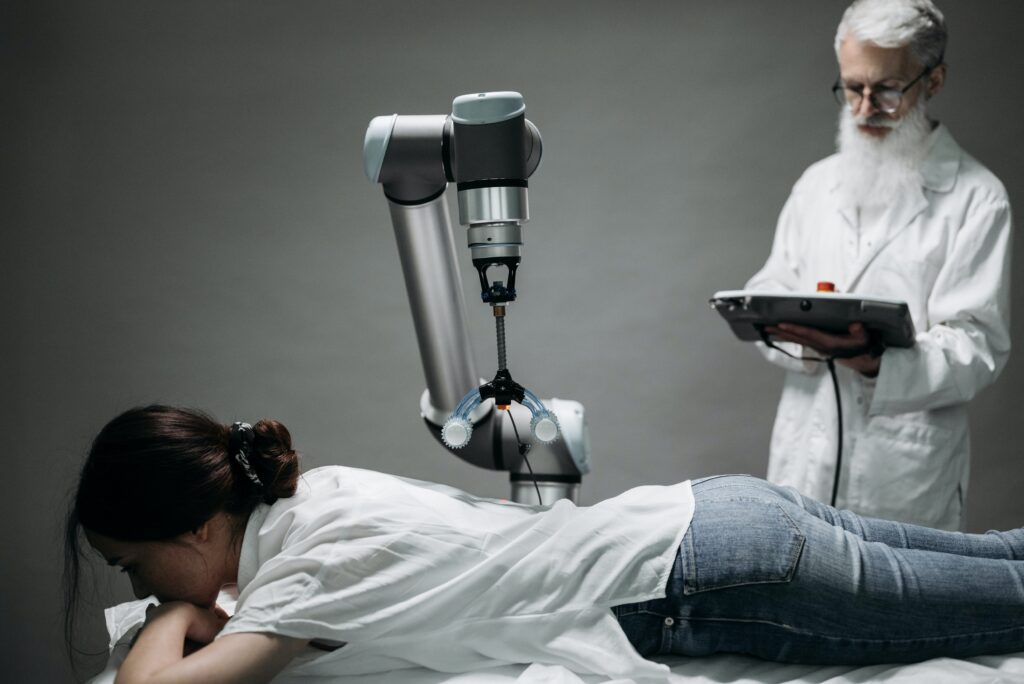Introduction
Advancements in technology have permeated nearly every aspect of modern life, and the field of medicine is no exception. Robotics in surgery has surfaced as a groundbreaking and transformative invention, revolutionizing the way surgical procedures are conducted. With its capability to enhance precision, improve patient issues, and minimize invasiveness, robotic- assisted surgery has become an integral element of modern healthcare. In this article, we claw into the world of robotics in surgery, exploring the benefits, challenges, and future prospects of this remarkable medical technology.
The integration of robot assisted surgery has surfaced as a game- changing paradigm, revolutionizing the field of medicine. Over the past many decades, robotics has transitioned from science fiction to touchable reality, offering precision, dexterity, and effectiveness that complement human expertise in the operating room. We’ll delve into the cutting- edge advancements in robotic surgery, exploring its operations, benefits, challenges, and the promising future it holds.
The Rise of Robotics in Surgery
The integration of robotics in surgery has been a gradual but remarkable journey. The conception of using robotic systems to assist surgeons in performing complex procedures first surfaced in the 1980s. though, it was not until the late 1990s that the first robotic surgical system, da Vinci Surgical System, received FDA approval for use in minimally invasive operations.
Understanding Robotic – Assisted Surgery
Robot- assisted surgery involves the use of advanced robotic systems to assist surgeons in performing complex procedures with matchless precision and control. Unlike traditional open surgeries, which bear large incisions and extended recovery times, robot- assisted procedures employ minor incisions, known as minimally invasive surgery, resulting in reduced pain, shorter hospital stays, and faster recovery times.
The da Vinci Surgical System
The da Vinci Surgical System, developed by Intuitive Surgical, stands at the forefront of robot- assisted surgery. This state of the art robotic platform comprises a surgeon’s console, robotic arms, and a high- definition camera, all controlled by the surgeon’s hand and foot movements. The system translates these movements into precise conduct by the robotic arms, offering 3D visualization and enhanced surgical capabilities.
Surgeon Training and Skill Development
The integration of robotics in surgery has necessitated technical training for surgeons to operate these sophisticated machines effectively. As a result, different training programs and simulators have been developed to help surgeons acquire the necessary skills. While this does add an initial learning curve, the long- term benefits of robotic- assisted surgery make the investment in training worthwhile.

Vital Advantages of Robotic Surgery
Precision and Accuracy
One of the most significant advantages of using robotics in surgery is the matchless precision they offer. Surgical robots are equipped with highly advanced sensors, cameras, and robotic arms, which allow surgeons to perform intricate movements with enhanced dexterity and delicacy. This position of precision is especially beneficial in delicate procedures similar as neurosurgery, cardiac surgery, and microsurgeries, where even the slightest error can have severe consequences.
Minimally Invasive Surgery (MIS)
Minimally invasive surgery has revolutionized the field of surgery by significantly reducing patient trauma and recovery time. Robot- assisted surgery plays a vital part in making MIS possible. Unlike traditional open surgeries, robotic surgery requires only minor incisions, as the robotic arms can maneuver with flexibility and reach areas that might be challenging to access manually. As a result, patients witness lower pain, reduced scarring, and faster recovery.
Improved Patient Outcomes
The integration of robotics in surgery has demonstrated substantial betterment in patient outcomes. With enhanced precision and reduced threat of complications, surgical robots contribute to lower post-operative infection rates, lowered blood loss, and shorter hospital stays. also, patients frequently witness reduced pain and discomfort, allowing them to resume their daily activities sooner.
3D Visualization
The high- definition 3D visualization provided by robotic systems allows surgeons to navigate intricate anatomy more efficiently, enhancing patient safety and surgical outcomes.
Surgeon Ergonomics
Robotic surgery offers enhanced ergonomics for surgeons, reducing physical strain during lengthy procedures and preventing surgeon fatigue.
Quicker Recovery
Cases who undergo robotic- assisted surgery frequently witness shorter hospital stays and a faster return to normal activities compared to traditional open surgeries.
Expanding Applications in Different Surgical Fields
Robotic Cardiovascular Surgery
In the realm of cardiovascular surgery, robots have been used for complex procedures similar as coronary artery bypass grafting, mitral valve repair, and atrial septal defect closure. These robotic approaches enable precise suturing and minimize trauma to the heart.
Robotic Gynecological Surgery
Robotic- assisted surgery has revolutionized gynecological procedures like hysterectomy, myomectomy, and sacrocolpopexy. The da Vinci Surgical System’s flexibility allows surgeons to navigate the pelvis with greater ease and preciseness.
Robotic Urological Surgery
In urology, robotic systems are extensively employed for radical prostatectomy, partial nephrectomy, and pyeloplasty. The robotic platform’s capability to execute intricate maneuvers helps preserve delicate structures and enhances patient issues.
Robotic General Surgery
Robotic systems are also making inroads into general surgery, including colorectal, pancreatic, and hepatobiliary procedures. With improved visualization and instrument manipulation, robotic- assisted surgery is transforming how complex cases are managed.
Challenges and Future Perspectives
While robotics in surgery continues to thrive, certain challenges remain :
a) Cost The initial investment and ongoing maintenance costs associated with robotic systems can be a significant barrier for some healthcare institutions.
b) Training Surgeons must undergo technical training to operate robotic platforms effectively, which could impact the rate of adoption.
c) Limited Haptic Feedback Current robotic systems lack full haptic feedback, which is the sense of touch and resistance that surgeons rely on during open surgeries.
Looking ahead, advancements in robotics, artificial intelligence, and haptic feedback technology hold great capability for overcoming these challenges and farther refining robotic- assisted surgery. As robots become more autonomous and surgeons gain increased proficiency, the synergy between human skill and robotic precision will continue to propel the field of surgery to new heights.
Future Prospects
The future of robotics in surgery appears promising, with ongoing research and development aiming to further enhance robotic systems’ capabilities. Advancements in artificial intelligence( AI) are anticipated to play a pivotal part in enabling robots to adapt to surgical scenarios dynamically. Also, the integration of haptic feedback technology may provide surgeons with a sense of touch, further enhancing their capability to navigate within the surgical site.
Conclusion
Robotics in surgery represents a paradigm shift in the medical world, enabling surgeons to perform intricate procedures with unprecedented precision and minimum invasiveness. The da Vinci Surgical System, along with other robotic platforms, has expanded the horizons of various surgical specialties, elevating patient care and outcomes to new levels. As the field of robotics evolves, continued research, development, and training will unleash even greater possibilities, solidifying robotics as a necessary tool in modern medicine. Embracing the collaboration between human ingenuity and technological invention, the future of robot- assisted surgery is brighter than ever before.

